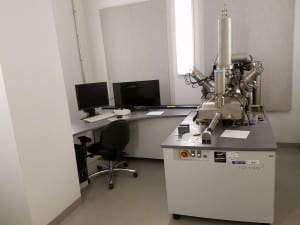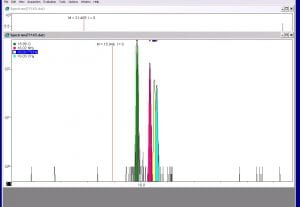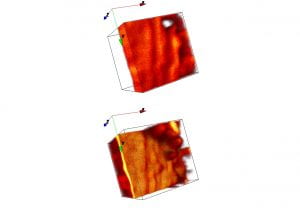High-Resolution 3D Elemental Analysis

The IONTOF 5-300 Time-of-Flight SIMS system uses a beam of ions to remove sub-monolayer amounts of material from a sample in vacuum. Some of those sputtered atoms become ionized in the process and are collected by electronic lenses.
The masses and position of origin of the collected molecules are precisely measured and can be used to generate high resolution 2D maps and 3D reconstructions of the elemental and chemical composition of the sample.
To reserve time or request training on this tool, click here or on the image at left to go to the ToF-SIMS tool page on SUMS.
 |
 |
 |
| High mass resolution gives ability to distinguish – from left to right above – O, NH2, 13^CH3, and CH4 despite just a 0.035 amu total mass separation. | Software can reconstruct elemental spatial distribution to create 3D images of a Ta cap(above-top) and Pt bulk (above-bottom) in an evaporator pellet. | Depth profile of Terfenol-D sample reveals multilayered structure and variation in layer growth conditions. |
Do you need to look at the boron diffusion profile in an ion-implanted semiconductor? Are you trying to determine the spatial distribution of organic molecules in a block-copoloymer or even an organic sample? How does one find the ratio of Nd:Gd in a new magnetic alloy and see whether they are spatially co-located when the grains are 5 microns in diameter and their combined overall concentration is a few parts per thousand?
All of these questions – or ones very similar – have been investigated using the ToF-SIMS system in the MCF. It is a versatile and unique platform for combining the chemical precision of mass spectroscopy, the spatial resolution of EM-based EDS, and the surface specificity of XPS.
[expand title="System Details:"]
There are three main system components:
- The primary ion gun or LMIG (Liquid Metal Ion Gun),
- The sputter gun or DSC-S (Dual Source Column – Sputtering), and
- The Analyzer
LMIG:
- Parameters: Bi cluster source (Bi+, Bi3+, Bi3++ ions available); Typical ion energy = 25kV; Ion current ~1 – ~300 pA at sample.
- Capabilities:
- Bunch mode – High mass resolution (m/Δm > 9000), moderate lateral resolution (~5 μm);
- Burst alignment mode – Unit mass resolution (m/Δm <100), high lateral resolution (~500 nm)
- Burst mode – High mass resolution (m/Δm > 5000), high lateral resolution (~1 μm)
DSC-S:
- Parameters: Dual ion source O+/O2+ or Cs+ ions; Ion energy 0.5, 1, or 2 kV; Ion current ~10 nA at sample.
- Capabilities:
- Enhanced ion yield for analyzing positive (O) or negative (Cs) ions
- Controllable and precise sputtering size down to 100 μm square
- Typical sputter rate for Si using O ions = ~0.5 nm/s
Analyzer:
- Parameters: Reflectron time-of-flight analyzer column; Path length ~1.5m.
- Capabilities:
- Able to detect positive or negative species from H up to mass > 10,000 amu
- Timing and counting integrated with LMIG
- Sensitivity down to ppm of a monolayer
[/expand]
Files:
ToFSIMS_New Software Instructions (JStark)
